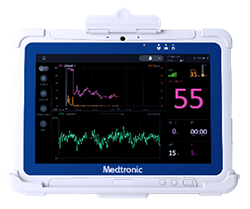New BIS™ Advance monitor coming to the market to help anesthesia providers personalize anesthesia dosing and improve patient outcomes1-5
Medtronic plc, a global leader in healthcare technology, announces U.S. Food and Drug Administration (FDA) 510(k) clearance for the BIS™ Advance monitor.

The new BIS™ Advance monitor delivers the clinically validated BIS™ algorithm with a completely redesigned interface that is easy to configure and use. Medtronic is planning to commercialize this device in the U.S. in the next few months.
Precision in anesthesia dosing is imperative during surgical procedurals, as too much or too little anesthesia can negatively affect patient outcomes. Continuing to leverage the validated BIS™ algorithm, the new BIS™ Advance monitor reflects the anesthetic effect on a patient’s brain, empowering anesthesia providers to tailor dosing to individual patient requirements.
Brain monitoring is recommended in multiple society guidelines for its benefits in improving patient outcomes related to enhanced recovery after surgery,6-8 total intravenous anesthesia (TIVA) procedures,9,10 and postoperative delirium.9,11-13As the market leader in processed EEG technology for depth of anesthesia monitoring, BIS™ technology provides meaningful insights which empowers clinicians to:
- Reduce anesthetic agent usage1,3,5
- Improve emergence and recovery time2,5
- Decrease postoperative delirium by up to 29% for better patient outcomes4
The BIS™ Advance monitor makes personalizing anesthesia easier. The large, high-resolution touchscreen monitor is simple to read with configurable data and settings so clinicians can see just the information they want. Plus, color-coordinated data lets clinicians quickly review readings.
“We are steadfast in our commitment to delivering anesthesia monitoring innovations to help clinicians keep patients safe,” said Frank Chan, president of the Acute Care & Monitoring business within the Medical Surgical Portfolio at Medtronic. “Innovations like the BIS™ Advance monitor makes personalized anesthesia dosing easier so clinicians can focus on what matters most — their patients.”
For more details and media assets, please visit our media kit.
Any forward-looking statements are subject to risks and uncertainties such as those described in Medtronic's periodic reports on file with the Securities and Exchange Commission. Actual results may differ materially from anticipated results.
Contacts:
Catherine Bosin Ryan Weispfenning
Public Relations Investor Relations
+1- 773-459-6579 +1-763-505-4626
References:
1. Gan TJ, Glass PS, Windsor A, et al. Bispectral index monitoring allows faster emergence and improved recovery from propofol, alfentanil, and nitrous oxide anesthesia. BIS Utility Study Group. Anesthesiology. Oct 1997;87(4):808-15. doi:10.1097/00000542-199710000-00014
2. Zhang C, Liang X, Sun Y-x, et al. Bispectral index monitoring prevent awareness during total intravenous anesthesia: a prospective, randomized, double-blinded, multi-center controlled trial. Chinese medical journal. 2011;124(22):3664-3669.
3. Punjasawadwong Y, Phongchiewboon A, Bunchungmongkol N. Bispectral index for improving anaesthetic delivery and postoperative recovery. Cochrane database of systematic reviews. 2014;(6)
4. Punjasawadwong Y, Chau‐in W, Laopaiboon M, Punjasawadwong S, Pin‐on P. Processed electroencephalogram and evoked potential techniques for amelioration of postoperative delirium and cognitive dysfunction following non‐cardiac and non‐neurosurgical procedures in adults. Cochrane Database of Systematic Reviews. 2018;(5)
5. Lewis SR, Pritchard MW, Fawcett LJ, Punjasawadwong Y. Bispectral index for improving intraoperative awareness and early postoperative recovery in adults. Cochrane Database of Systematic Reviews. 2019;(9)
6. Gustafsson UO, Scott MJ, Hubner M, et al. Guidelines for Perioperative Care in Elective Colorectal Surgery: Enhanced Recovery After Surgery (ERAS(®)) Society Recommendations: 2018. World J Surg. Mar 2019;43(3):659-695. doi:10.1007/s00268-018-4844-y
7. Feldheiser A, Aziz O, Baldini G, et al. Enhanced Recovery After Surgery (ERAS) for gastrointestinal surgery, part 2: consensus statement for anaesthesia practice. Acta Anaesthesiol Scand. Mar 2016;60(3):289-334. doi:10.1111/aas.12651
8. Thorell A, MacCormick AD, Awad S, et al. Guidelines for Perioperative Care in Bariatric Surgery: Enhanced Recovery After Surgery (ERAS) Society Recommendations. World J Surg. Sep 2016;40(9):2065-83. doi:10.1007/s00268-016-3492-3
9. Guidance ND. Depth of anaesthesia monitors‑Bispectral index (BIS), E‑‑Entropy and Narcotrend Compact M 2012.[on‑line].[cit. 2019‑06‑18]. Dostupné z: http://www.nice.org.uk/dg6.
10. Nimmo AF, Absalom AR, Bagshaw O, et al. Guidelines for the safe practice of total intravenous anaesthesia (TIVA): Joint Guidelines from the Association of Anaesthetists and the Society for Intravenous Anaesthesia. Anaesthesia. Feb 2019;74(2):211-224. doi:10.1111/anae.14428
11. Postoperative delirium in older adults: best practice statement from the American Geriatrics Society. J Am Coll Surg. Feb 2015;220(2):136-48.e1. doi:10.1016/j.jamcollsurg.2014.10.019
12. Fencl JL. Guideline Implementation: Moderate Sedation/Analgesia. Aorn j. May 2016;103(5):500-11. doi:10.1016/j.aorn.2016.03.001
13. Aldecoa C, Bettelli G, Bilotta F, et al. Update of the European Society of Anaesthesiology and Intensive Care Medicine evidence-based and consensus-based guideline on postoperative delirium in adult patients. Eur J Anaesthesiol. Feb 1 2024;41(2):81-108. doi:10.1097/eja.0000000000001876
The BIS™ Advance monitor should not be used as the sole basis for diagnosis or therapy and is intended only as an adjunct in patient assessment.
